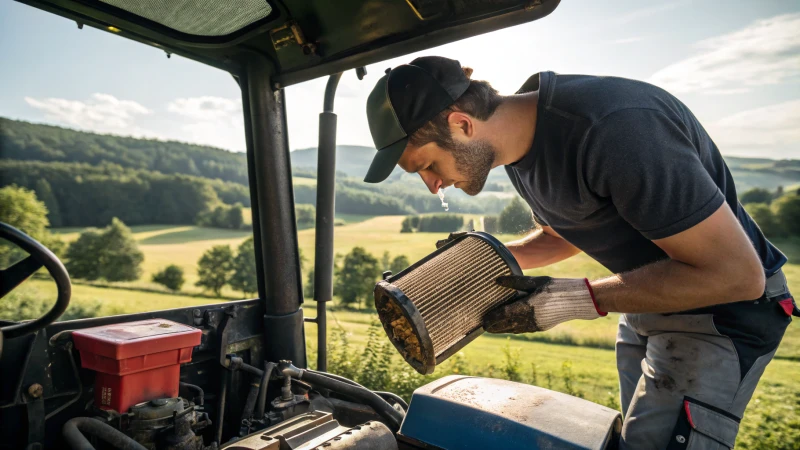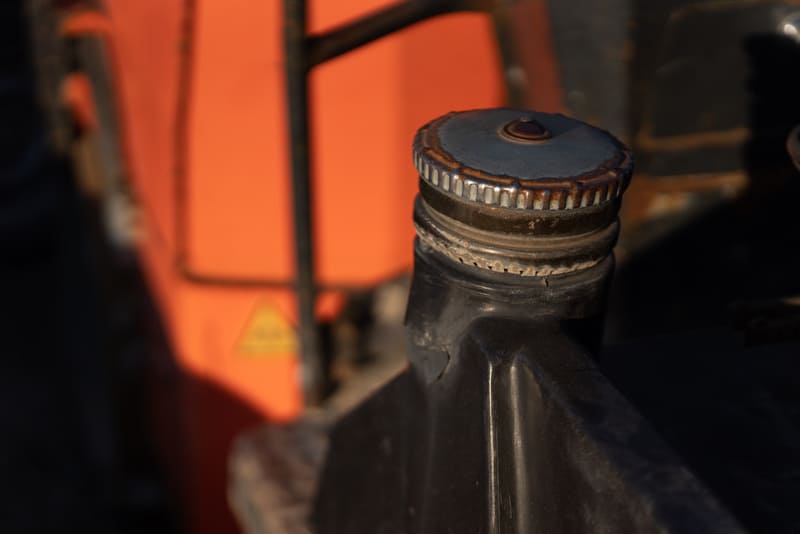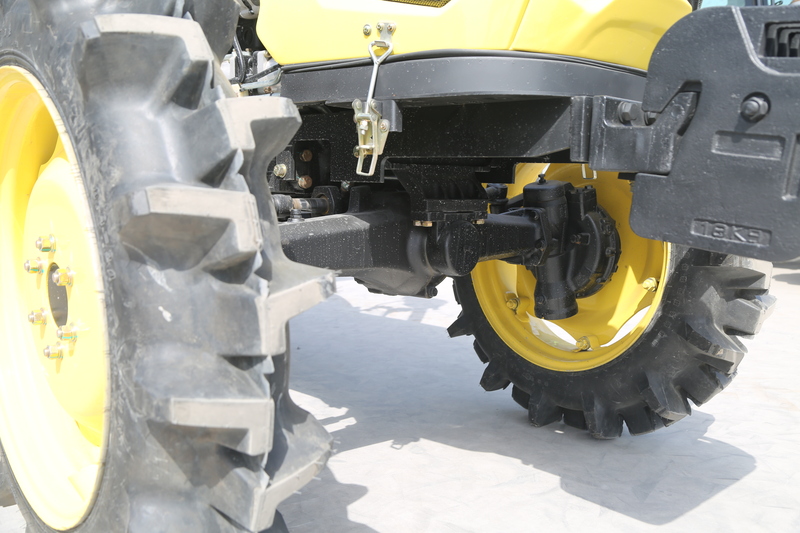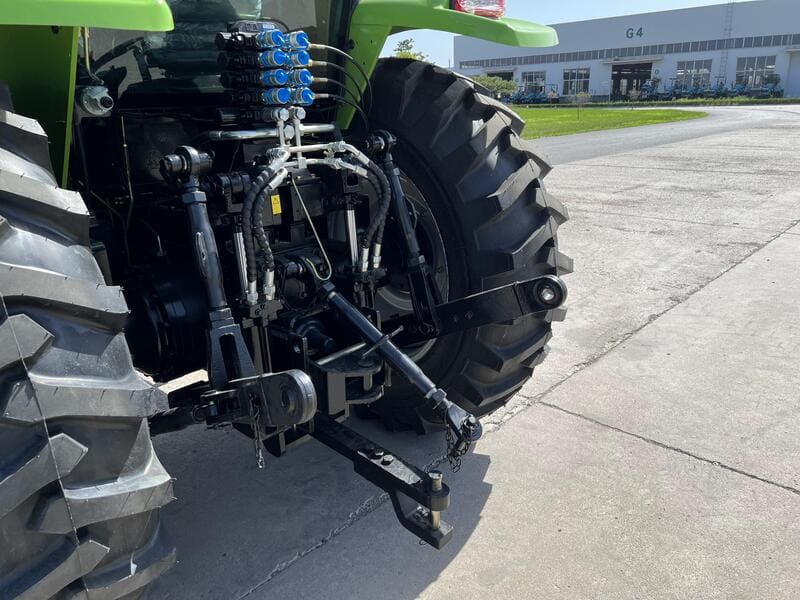Ever wondered if your trusty tractor is as ready for action as you are? Maintaining it is key to smooth operations.
The six essential tractor maintenance practices are checking and replacing engine oil, cleaning or replacing air filters, maintaining the coolant system, inspecting tire pressure, maintaining the hydraulic system, and ensuring proper greasing and lubrication. These steps help prevent wear, improve efficiency, and extend the tractor's lifespan.
Whenever I think about tractor maintenance, I’m reminded of a time when I skipped a routine check-up because I thought I was too busy. Boy, did I regret it! The tractor had issues right in the middle of planting season. That’s when I learned that a bit of prevention goes a long way. So, let’s dive deeper into these practices and how they can help you avoid those dreaded breakdowns.
Regular engine oil changes extend tractor lifespan.True
Changing engine oil regularly prevents wear and improves efficiency.
Ignoring tire pressure doesn't affect tractor performance.False
Proper tire pressure is crucial for optimal tractor performance.
How Often Should You Check and Replace Engine Oil?
Have you ever stood in front of your car, dipstick in hand, pondering just how often you should be checking and changing that engine oil? You're not alone.
I make it a point to check my engine oil every month and replace it every 5,000 to 7,500 miles, or follow my car manufacturer’s guidelines. This routine keeps my engine purring smoothly and prolongs its life.

Understanding Engine Oil Basics
Think of engine oil as the lifeblood of your car—it keeps everything running smoothly by reducing friction, cooling the engine, and ensuring longevity. There was a time when I learned this the hard way, driving with low oil, only to hear the unsettling sounds of metal on metal. That experience taught me the importance of monthly checks.
Factors Affecting Oil Change Frequency
Every vehicle has its quirks, much like us. How often you change your oil depends on your car’s age, type, and driving habits. I remember switching from city to country roads after moving, which meant adjusting my oil change intervals. Older vehicles or those often driven in harsh conditions need more frequent changes.
| Driving Condition | Recommended Change Interval |
|---|---|
| City Driving | Every 3,000 to 5,000 miles |
| Highway Driving | Every 5,000 to 7,500 miles |
| Off-road or Towing | Every 3,000 to 4,000 miles |
Manufacturer Recommendations
Your car’s owner manual is like a trusted friend who knows all the secrets. It provides specific oil change intervals. Many modern cars even have systems that alert you when it's time to change the oil. Once, I ignored these alerts out of sheer busyness—never again! They help keep my warranty intact and my car running at peak performance.
The Role of Synthetic Oil
I've recently switched to synthetic oils for their long-lasting protection. They offer enhanced performance, especially for high-stress driving conditions. If you're considering it too, learn more about synthetic oils1 and see if they suit your car's needs.
Signs It's Time to Change Your Oil
Sometimes, your car sends out SOS signals that shouldn't be ignored—like unusual noises or increased exhaust smoke. These signs once led me to discover that my oil was dirty and degraded. Identify symptoms of oil issues2 early on to prevent costly damage.
Keeping up with regular oil changes can add years to your vehicle’s life. Whether navigating city streets or exploring rugged terrains, knowing when and how often to change your oil keeps your engine happy. Always turn to your owner’s manual or a trusted mechanic for advice tailored to oil maintenance3.
Check engine oil monthly for optimal performance.True
Monthly checks ensure adequate oil levels and prevent contamination.
Synthetic oils require changes every 3,000 miles.False
Synthetic oils last longer and don't need such frequent changes.
How Do You Keep Your Tractor’s Air Filter in Top Shape?
Imagine the sun rising over a field as your tractor hums to life, ready to tackle another day. Keeping its air filter in top shape ensures it runs smoothly and efficiently.
The best way to maintain your tractor's air filter is by regularly checking it for dirt and damage, cleaning it with compressed air if reusable, and replacing it when necessary. This routine helps prevent engine issues caused by dust and debris.

Understanding the Importance of Air Filter Maintenance
I remember the first time I realized the importance of a clean air filter. It was a dusty day on the farm, and halfway through my chores, the tractor started sputtering. A quick check revealed a clogged filter, choking the engine like a marathon runner without enough air. That's when it hit me: maintaining that little filter could make or break a day's work.
Tractors operate in environments where dust and debris are prevalent, making air filter maintenance vital. A clean air filter allows efficient air intake, improving fuel combustion4 and reducing emissions.
Inspection Frequency
Now, I've made it a habit to inspect the air filter every 50-100 hours, or more often if I'm working in particularly dusty conditions. It's like giving my tractor a regular health check-up—simple but essential. These frequent checks help me catch any potential issues early, ensuring my work isn't interrupted by unexpected hiccups.
Regular inspections are key. Check the air filter every 50-100 hours, or sooner in dusty conditions. Frequent checks can help identify when cleaning or replacement is necessary, ensuring uninterrupted performance.
Cleaning Techniques
When it comes to cleaning a reusable air filter, I’ve found that using compressed air works wonders. Holding the filter at a safe distance, I make sure to blow air from the inside out, following the airflow direction. This method effectively removes trapped particles without causing damage.
If the air filter is reusable, clean it using compressed air. Hold the filter at a safe distance to prevent damage. Ensure the airflow direction matches that of normal operation to expel trapped particles effectively.
| Step | Action |
|---|---|
| 1. Removal | Detach the air filter from its housing. |
| 2. Inspection | Check for tears, holes, or significant wear. |
| 3. Cleaning | Use compressed air from the inside out. |
| 4. Reinstall | Replace if cleaned; otherwise, fit a new one. |
When to Replace
There are times when cleaning just doesn't cut it—if the filter looks beyond repair or doesn’t regain its shape and color, it's time for a replacement. A new filter means peace of mind knowing my tractor's engine is protected from harmful contaminants.
Replace the air filter if cleaning does not restore its condition or if it appears damaged. A new filter ensures optimal protection against engine contaminants5 and enhances tractor longevity.
Choosing the Right Replacement
I've learned that selecting an OEM (Original Equipment Manufacturer) part is crucial for compatibility and performance. While it might be tempting to save a few bucks with cheaper alternatives, those can lead to increased engine wear and inefficiencies—definitely not worth the risk.
When selecting a replacement, consider OEM (Original Equipment Manufacturer) parts for guaranteed compatibility and performance. Using substandard filters can lead to increased engine wear and operational inefficiencies6.
Incorporating these practices into my routine has not only extended my tractor's engine life but also boosted its efficiency on those long workdays.
Air filters should be checked every 50-100 hours.True
Regular inspections every 50-100 hours help maintain performance.
Compressed air should be used from the outside in.False
Use compressed air from the inside out to expel particles.
Why Is Coolant System Maintenance Critical for Tractors?
You know, maintaining the coolant system in your tractor is like giving it a hug—it keeps everything running smoothly and ensures your machine doesn't overheat under pressure.
Keeping your tractor's coolant system in top shape prevents overheating, reduces corrosion, and maintains peak performance. Regular inspections and timely coolant changes help you avoid expensive repairs and ensure your tractor stays on the job.

The Role of the Coolant System
I remember one hot summer day out in the fields, pushing my tractor to its limits, when I suddenly noticed the engine temperature gauge creeping dangerously high. Thankfully, I managed to avoid disaster because I'd been diligent with my coolant system maintenance. The coolant system is the unsung hero, ensuring the engine stays cool even when I'm working it hard. Without it, the risk of overheating—and the damage it could cause—would be all too real.
Preventing Corrosion and Rust
A friend of mine learned the hard way about the importance of maintaining coolant additives. He had neglected regular flushes, and before he knew it, corrosion had started causing blockages that led to inefficiencies and costly repairs. These additives might seem trivial, but they play a crucial role in keeping rust and corrosion at bay.
| Common Additives | Function |
|---|---|
| Anti-corrosion agents | Prevent rust |
| Anti-freeze compounds | Lower freezing point |
The Economic Impact of Poor Maintenance
Ignoring coolant system maintenance can hit your wallet hard. I've seen fellow farmers face steep repair bills because they overlooked this aspect of tractor care. Overheating can warp engine parts, leading to downtime and expensive fixes. Regular inspections7 can catch small issues before they become budget-busting problems.
Signs of Coolant System Issues
I've learned to watch for signs that something might be amiss:
- Frequent overheating
- Odd noises from the engine
- Leaks around the cooling system
- A sweet smell near the engine—it's a dead giveaway of a coolant leak.
Best Practices for Coolant System Care
- Regular Checks: I make it a habit to check my tractor's coolant levels and condition daily.
- Use Recommended Coolants: Only manufacturer-recommended coolants make their way into my engine.
- Flush System Annually: I don't skip this—an annual flush keeps things running smoothly.
- Inspect for Leaks: Regularly checking hoses and connections helps me spot potential issues early.
By sticking to these practices, I've kept my tractor humming along efficiently, saving time and money in the long haul. Taking a proactive approach ensures my equipment doesn't surprise me with an unexpected breakdown8.
Coolant system maintenance prevents engine overheating.True
Regular maintenance ensures the engine operates within a safe temperature range.
Ignoring coolant system maintenance has no economic impact.False
Neglecting maintenance can lead to costly repairs and downtime.
How Can Regular Tire Checks Boost Your Tractor's Performance?
Ever noticed how your tractor's performance can hinge on something as simple as tire maintenance? It's the small things that often make the biggest difference.
Regular tire checks enhance tractor performance by maintaining optimal traction, stability, and fuel efficiency. They allow for early detection of wear and tear, preventing costly repairs and extending the tractor's lifespan.

Importance of Tire Maintenance
I remember the day when I was halfway through a field, and my tractor suddenly felt like it was dragging its feet. It turned out to be under-inflated tires. Regular maintenance is crucial because properly inflated tires ensure even weight distribution, reducing soil compaction and enhancing field performance. By inspecting tires regularly for wear and damage, you can avoid these unexpected interruptions.
Fuel Efficiency and Cost Savings
On one occasion, my fuel costs were inexplicably high. After some investigation, I discovered that my tractor's tires were under-inflated, causing increased rolling resistance. Keeping them at the recommended tire pressure9 not only boosted my fuel efficiency but also saved me money. Regular checks can help spot leaks or punctures that might otherwise remain hidden.
Safety and Stability
Driving across uneven terrain always makes me a little anxious. The last thing anyone wants is an accident due to worn or damaged tires compromising stability. That's why I make it a point to inspect them thoroughly before each use, ensuring both my safety and that of the machinery.
Tire Wear Patterns
Ever noticed uneven wear on your tires? It happened to me once, signaling alignment issues and improper inflation. Monitoring these patterns is vital because they can indicate if your tractor isn't balanced correctly. Making adjustments based on these insights can really prolong tire life.
| Tire Check | Frequency | Benefits |
|---|---|---|
| Pressure | Weekly | Fuel efficiency, safety |
| Tread Depth | Monthly | Traction, even wear |
| Visual Damage | Before Use | Prevents unexpected failure |
How to Perform Regular Checks
Investing in quality tools like a reliable pressure gauge has become second nature for me. It ensures accurate readings every time. I make sure to consult my tractor's manual for the recommended PSI levels and perform checks on both the front and rear tires. Replacing any damaged tires promptly is key to avoiding compromised performance.
Learning from Experts
I've found that exploring resources like agricultural maintenance guides10 keeps me informed about the latest techniques in tire maintenance. Industry experts offer valuable insights into best practices that are easy to incorporate into my routine.
The Impact on Productivity
Well-maintained tires mean more time in the field and less downtime for repairs. I've noticed how they contribute to seamless operation, reducing the likelihood of flat tires or blowouts. This boosts productivity significantly, as my tractors spend more time working rather than being sidelined.
Incorporating a routine tire check schedule not only enhances your tractor's performance but also extends its operational life, ultimately leading to cost savings and improved productivity for your agricultural business. Taking proactive steps towards tire maintenance is truly an investment in your equipment's future success.
Under-inflated tires increase fuel consumption.True
Under-inflated tires cause higher rolling resistance, using more fuel.
Tire checks are unnecessary for tractor safety.False
Regular tire checks ensure stability and prevent accidents on uneven terrain.
What Are Common Hydraulic System Issues and How to Prevent Them?
Ever wondered why your hydraulic system suddenly sputters to a halt?
Common hydraulic issues such as leaks, overheating, and contamination can disrupt operations. By regularly inspecting hoses and replacing filters, maintaining fluid levels, and ensuring cleanliness, these problems can be prevented, ensuring your hydraulic system runs smoothly.

Identifying Common Hydraulic System Issues
I've seen firsthand how hydraulic systems can seem like the backbone of machinery until something goes awry. Picture this: I was once overseeing a large agricultural operation when we noticed a slowdown in productivity—turned out, it was a pesky hydraulic leak. These systems can be so intricate, and yet, the issues are often painfully familiar:
- Leaks: From experience, I know leaks often sneak up on you, courtesy of worn seals or nicks in hoses that compromise fluid pressure.
- Overheating: Nothing like the fear of overheating—I've felt it! It can stem from low fluid levels, contamination, or just parts getting old and tired.
- Contamination: Once, a colleague of mine found a whole lot of dirt had crept into the system, degrading the fluid and threatening the components. It's surprising how a little grime can cause big problems.
Prevention Through Regular Maintenance
The secret to sidestepping these headaches? Good old-fashioned maintenance. I swear by it! Here's a quick guide:
| Issue | Prevention Tips |
|---|---|
| Leaks | Inspect seals and hoses regularly. Replace damaged parts. |
| Overheating | Check fluid levels; ensure proper cooling mechanisms. |
| Contamination | Use high-quality filters; regularly change hydraulic fluid. |
I've learned that keeping an eagle eye on critical components11—like pumps, valves, and actuators—can really make a difference. Regular checks not only catch potential problems early but also save you from future stress.
Monitoring and Diagnostics
I've become quite the fan of diagnostic tools over the years. They give you real-time insights into pressure levels, temperatures, and even potential leaks. It's like having a guardian angel for your hydraulic system.
And don't get me started on predictive maintenance12! Techniques like vibration analysis or thermal imaging offer data that lets us nip issues in the bud before they escalate.
Choosing the Right Hydraulic Fluids
Ah, the quest for the perfect hydraulic fluid—it's more than just picking something off the shelf. You have to consider viscosity, temperature stability, and anti-wear properties to ensure it suits your system's specific needs.
Always check manufacturer guidelines13 to make sure you're using compatible fluids. Trust me, it makes all the difference in performance.
With a solid grasp of these common issues and preventive strategies, I've managed to keep equipment running smoothly and downtime minimal—essential for keeping any operation humming along.
Leaks in hydraulic systems are mainly due to worn-out seals.True
Worn-out seals cause leaks by failing to contain hydraulic fluid effectively.
Overheating is never caused by improper fluid levels.False
Improper fluid levels can lead to overheating by affecting heat dissipation.
How Does Proper Greasing Extend Tractor Longevity?
Ever wondered how a simple routine like greasing can keep your tractor running smoothly for years?
Proper greasing reduces friction and wear in tractor components, leading to extended longevity. Regular lubrication helps maintain smooth operation, preventing breakdowns and costly repairs. Use quality grease and follow manufacturer guidelines for optimal results.

Importance of Regular Greasing
I remember the first time I realized the magic of regular greasing. My old tractor, which had been groaning under the weight of many years of hard work, suddenly seemed to purr like a contented cat after a thorough greasing session. It was as if the machine was thanking me for taking care of its aching joints. Greasing isn’t just about maintenance; it’s about giving your tractor the attention it deserves so that it continues to serve you well.
Key Benefits:
- Reduces Friction: Just like how our joints need oiling as we age, metal parts in tractors need proper lubrication to glide smoothly against each other, cutting down on friction14 and preventing wear.
- Prevents Corrosion: I found out the hard way that rust is a sneaky enemy. Grease acts as a protective shield, keeping moisture at bay and parts rust-free.
- Improves Fuel Efficiency: It’s amazing how much smoother and more efficient the ride gets when every part is well-oiled, reducing the strain on the engine and saving fuel.
Components That Require Regular Greasing
Through trial and error, I learned where my attention was most needed. Here’s a handy list I’ve compiled from my own experience:
| Component | Why it Needs Greasing |
|---|---|
| Bearings | To prevent overheating and failure |
| Hinges | To ensure smooth opening and closing |
| Joints | To maintain flexibility and movement |
| Pins and Bushings | To reduce wear due to movement |
Focusing on these parts can significantly impact15 the overall functionality of your tractor. It’s like giving each part its own spa day!
Best Practices for Tractor Greasing
Here’s what I’ve learned over the years:
- Use Quality Grease: Don’t skimp on this. High-quality grease according to manufacturer specs is worth its weight in gold.
- Follow Manufacturer Guidelines: Each tractor has its quirks. Stick to what the manual advises for optimal performance16.
- Regular Inspection: Make it a habit to check those grease points. A blocked or dried-out point can be a silent troublemaker.
Sticking to a regular greasing schedule has saved me countless headaches and downtime. It's like giving your tractor a regular health check-up—simple but incredibly effective. Always consult expert resources or your tractor’s manual for any model-specific guidance. Trust me, your tractor will thank you with years of faithful service.
Regular greasing prevents tractor component corrosion.True
Grease acts as a barrier against moisture, preventing rust.
Ignoring greasing does not affect tractor fuel efficiency.False
Lack of lubrication increases friction, requiring more energy and fuel.
Conclusion
Learn essential tractor maintenance practices, including oil changes, air filter care, coolant system checks, tire inspections, hydraulic upkeep, and greasing to enhance performance and extend lifespan.
-
This link explains the advantages of synthetic oils, including better performance in extreme temperatures. ↩
-
Discover common signs that indicate it's time for an oil change, helping prevent costly engine damage. ↩
-
Learn practical tips for maintaining optimal engine oil levels and quality for better vehicle health. ↩
-
Discover the connection between a clean air filter and improved fuel combustion efficiency in tractors. ↩
-
Learn about the types of contaminants that can harm your tractor's engine without proper air filtration. ↩
-
Understand why OEM parts are crucial for maintaining tractor performance and avoiding operational issues. ↩
-
Find out how regular inspections can prevent costly tractor repairs and downtime. ↩
-
Discover how maintaining your coolant system can avert unexpected tractor breakdowns. ↩
-
Understanding the optimal tire pressure ensures efficient fuel usage and prevents unnecessary wear, saving costs. ↩
-
These guides offer expert advice on maintaining agricultural tires, helping improve operational efficiency. ↩
-
Discover detailed inspection procedures that highlight why focusing on critical components prevents future failures. ↩
-
Learn how predictive maintenance can enhance system reliability and reduce unexpected breakdowns. ↩
-
Explore guidelines for choosing the right hydraulic fluids to ensure system compatibility and efficiency. ↩
-
Learn how grease minimizes friction between moving parts, preventing wear. ↩
-
Understand how consistent maintenance enhances tractor efficiency and durability. ↩
-
Explore why adhering to guidelines ensures optimal machinery performance. ↩




